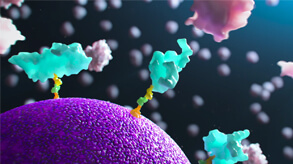SomaScan® Menu Terminology
View our list of SomaScan® Menu Terminology
Primary SOMAmer® Reagent and Protein Target Annotation
SeqID – The SomaLogic® identifier for this SOMAmer Reagent.
SomaId – The SomaLogic identifier for the protein used to develop the SOMAmer Reagent.
Target Name – The abbreviated SomaLogic name for the target protein used to develop the SOMAmer Reagent.
Target Full Name – The SomaLogic full name for the target protein used to develop the SOMAmer Reagent.
UniProt ID – The UniProt identifier for the protein measured by the SOMAmer Reagent.
Type – A general classification of the original target used to develop the SOMAmer Reagent or those for internal use purposes.
Organism – The organism in which this reagent’s target protein is expressed.
Dilution – Plasma and serum samples are serially diluted to measure proteins within the dynamic range of the SomaScan Assay. Each SOMAmer Reagent is assigned to one of three established sample dilutions empirically determined during assay development.
SELEX Target Accession – The supplier accession number for the protein used in the SELEX process to generate this SOMAmer Reagent. (ex. RefSeq, UniProt, European Nucleotide Archive, etc.)
SELEX Target Amino Acid Range – The amino acid range of the protein used to develop the SOMAmer Reagent per the referenced accession number if provided by the protein supplier.
Protein Construct Graph – The primary amino acid sequence of the protein used in the development of each SOMAmer Reagent dictates the epitopes available for binding. SOMAmer Reagents may be developed against full-length or truncated proteins, different protein domains, isoforms, etc. This graph indicates the primary amino acid sequence range of the recombinant protein (grey or blue bar) used in the selection of each reagent (y-axis) relative to the amino acid sequence of the full-length analyte (x-axis, black bar). The SOMAmer Reagent binding epitope will be within the range of the protein construct used to select the reagent.
SELEX Target Expression System – The class of expression system used by the protein supplier to produce the protein target used in SELEX (if expression information is provided by the supplier).
Buffer Performance
LoD in Buffer (RFU) – The limit of detection from repeated assay buffer measurements across 15 validation runs.
The LoDB computation is: LoDB = median signal of the blank samples plus 3*standard Median Absolute Deviation of the blank.
Performance in Human Plasma
Signal-to-Noise Plasma – Ratio of the median signal from a set of healthy individuals divided by the noise for nine runs (average buffer signal plus three standard deviations). Reflects the fold difference of signal in a set of healthy individuals relative to the LoDB.
Intra-Plate CV Plasma – The within-run coefficient of variation for SOMAmer Reagents in a test of triplicates from four healthy plasma samples run across 15 plates.
Inter-Plate CV Plasma – The between-run coefficient of variation for SOMAmer reagents in a test of triplicates from four healthy plasma samples run across 15 plates.
Total CV Plasma – Measurement used to express the overall variability (coefficient of variation) for a SOMAmer Reagent in a test of triplicates from four healthy plasma samples run across 15 plates.
Correlation Coefficient Plasma – The average rank-order Spearman correlation of a SOMAmer Reagent between multiple runs from a set of 15 individual plasma samples.
F-Statistic Plasma – Ratio of signal variance from a set of healthy individuals over signal variance from technical replicates. F-statistics above the critical value (2.43) indicate measured biological differences across the tested population set were differentiated from technical assay noise.
Lower 95% Normal (RFU) Plasma – The lower 95% relative fluorescence units (RFU) for plasma derived from about 1000 healthy individuals.
Median Normal (RFU) Plasma – The median RFU value on a test of human plasma derived from about 1000 healthy individuals.
Upper 95% Normal (RFU) Plasma – The upper 95% RFU for plasma derived from about 1000 healthy individuals.
Performance in Human Serum
Signal-to-Noise Serum – Ratio of the median signal from a set of healthy individuals divided by the LoDB for a given SOMAmer Reagent. Reflects the fold difference of signal in a set of healthy individuals relative to the LoDB.
Intra-Plate CV Serum – The within-run coefficient of variation for SOMAmer Reagents in a test of triplicates from four healthy serum samples run across 15 plates.
Inter-Plate CV Serum – The between-run coefficient of variation for SOMAmer Reagents in a test of triplicates from four healthy serum samples run across 15 plates.
Total CV Serum – Measurement used to express the overall variability (coefficient of variation) for a SOMAmer Reagent in a test of triplicates from four healthy serum samples run across 15 plates.
Correlation Coefficient Serum – The average rank-order Spearman correlation of a SOMAmer Reagent between multiple runs from a set of 15 individual serum samples.
F-Statistic Serum – Ratio of signal variance from a set of healthy individuals over signal variance from technical replicates. F-statistics above the critical value (2.43) indicate measured biological differences across the tested population set were differentiated from technical assay noise.
Lower 95% Normal (RFU) Serum – The lower 95% RFU for serum derived from about 1000 healthy individuals.
Median Normal (RFU) Serum – The median RFU value on a test of human serum derived from about 1000 healthy individuals.
Upper 95% Normal (RFU) Serum – The upper 95% RFU for serum that is derived from about 1000 healthy individuals.
Secondary Annotation
Entrez Gene Name – The Entrez Gene name for the gene encoding the target protein used to develop this SOMAmer Reagent.
Entrez Gene ID – The Entrez Gene identifier for the gene encoding the target protein used to develop this SOMAmer Reagent.
Ensembl Gene ID – The Ensembl Gene ID for the gene encoding the target protein used to develop this SOMAmer Reagent.
HGNC ID – The HGNC ID for the gene encoding the target protein used to develop this SOMAmer Reagent.
SELEX Target Name – The original name of the expected target when SELEX was performed. The “Target Name” above was updated to accurately reflect the identity of the SOMAmer Reagent target protein after additional investigation.
SELEX UniProt ID – The UniProt ID of the expected target when SELEX was performed. The “UniProt ID” above was updated to accurately reflect the identity of the SOMAmer Reagent target protein after additional investigation.
Published Characterization of Binding and Specificity
Orthogonal Strategies – PubMed identifier for publications to a variety of methods that use SOMAmer Reagent-independent techniques to quantify and confirm protein identity and level of expression. Examples include ELISA, Histochemistry, Western Blot, Particle-Based Immunoassay, and more.
MRM-MS Data – PubMed identifier for publications with results of Multiple Reaction Monitoring (MRM), mass spectrometry technique that determines protein content in a biological sample after SOMAmer enrichment.
DDA-MS Data – PubMed identifier for publications with results of Data Dependent Acquisition (DDA), mass spectrometry technique to determine protein content after SOMAmer enrichment via pull down testing in matrix (plasma, urine, serum).
pQTL – PubMed identifier for publications. Proteins may be orthogonally confirmed using a variety of genetic strategies (such as cis pQTL associations) that directly link a gene to a protein and a SOMAmer reagent.
Internal Characterization of Binding and Specificity
Buffer Pull-down Assay – Pull-down assays are performed in buffer using a SOMAmer Reagent and target protein. Protein-SOMAmer Reagent complexes isolated from the pull down assay are separated via SDS PAGE. Reagents must be able to isolate a protein matching the molecular weight of the target protein used to develop the SOMAmer Reagent to qualify for the final menu.
Selectivity – When available, proteins with significant homology to the SOMAmer Reagent target protein (greater than 40% sequence identity with the target protein or members of the same protein family) were used in a pull-down assay to test the cross reactivity of a SOMAmer Reagent. In instances where cross reactivity was observed, binding assays were used to determine the affinity of a reagent for its non-cognate protein.
Buffer Mass Spec – Confirmation of specificity to the target protein was identified following LC-MS/MS analysis of Protein-SOMAmer Reagent complexes isolated from a buffer pull down assay.
Plasma Mass Spec – Confirmation of specificity via pull-down assays with SOMAmer Reagents were used to enrich proteins from complex biological matrices (human plasma, human serum, cell lysate, urine, etc.). Enrichment of the target analyte relative to controls was determined using mass spectrometry.
Additional Characterization Info – A string indicating if characterization experiments were executed for this reagent.




